Understanding the Maritime Flag Alphabet
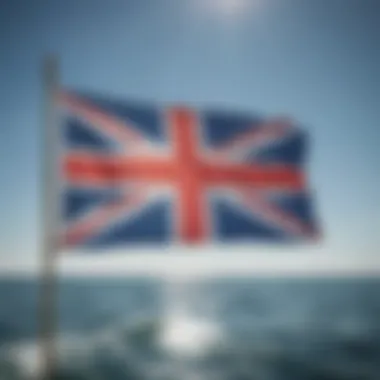
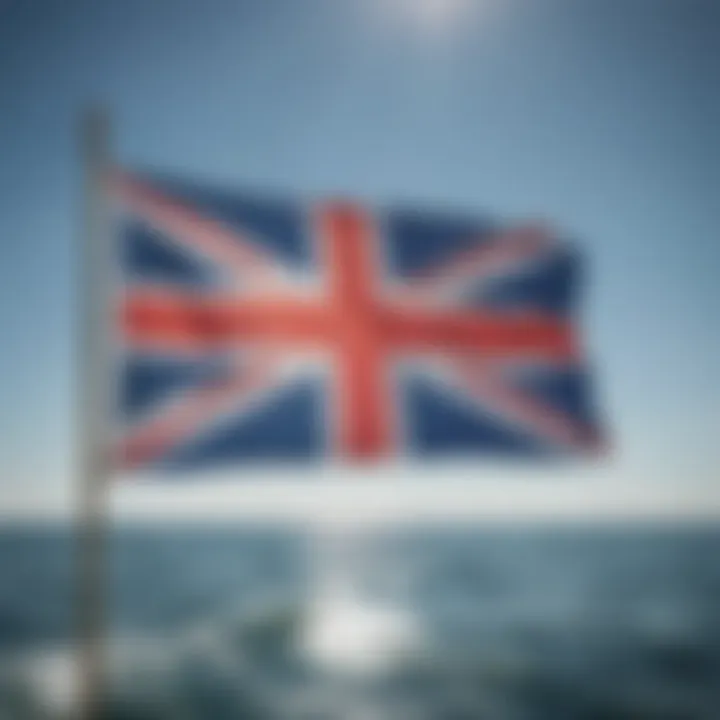
Intro
Understanding the maritime flag alphabet is akin to learning a new language, one that speaks to adventurers and sailors navigating the vast expanses of water. This unique system, over centuries, has served as a pivotal communication tool, where flags become the voice of vessels lost to the winds and waves. By employing different colored flags, each representing a letter of the alphabet, maritime culture established a visual method of signaling that is indispensable in today's nautical practices.
This guide shines a light on the history, significance, and practical applications of the maritime flag alphabet, aiming to deepen the appreciation of this fundamental aspect of sailing and watersports. From the basics of flag identification to the rich tapestry of maritime signaling, this exploration caters to seasoned sailors and enthusiastic learners alike, ready to embrace the allure of the seas with informed confidence.
Techniques and Skills
Essential Techniques for Beginners
For those venturing into the realm of maritime communication, grasping the fundamentals is crucial. Familiarity with the flags entails recognizing their colors, shapes, and unique designs. Beginners should focus on:
- Learning Each Flag: Memorize the flags associated with each letter. Visual aids such as charts or flashcards can be very helpful in retaining this information.
- Practicing Basic Signals: Start with simple messages. For instance, signaling "I need assistance" can be practiced using the appropriate flags.
- Understanding Weather Conditions: Recognize that visibility and wind conditions impact flag signaling. On a foggy day, for example, signaling might be less effective.
Advanced Skills for Experienced Watersport Enthusiasts
Navigating beyond the basics, seasoned sailors should delve into more complex aspects of flag signaling. Some advanced skills include:
- Combining Flags for Messages: Use multiple flags together to convey more nuanced messages. The flags can be arranged in specific sequences to deliver detailed instructions or alerts.
- Understanding International Code Signals: Familiarize oneself with the International Code of Signals, which expands the uses of these flags beyond English letters. This also includes distress signals recognizable by sailors worldwide.
- Adapting to Different Scenarios: Adapt your communication strategy based on the situation—whether you’re racing, cruising, or responding to emergencies, ensuring your signaling aligns with the context is crucial.
"A proper understanding of the flag signals ensures that every sailor can find common ground on the turbulent waters of communication."
By mastering these techniques and skills, both novices and experts in the watersport community can enhance their navigational prowess, ensuring safe and effective communication during their endeavors at sea.
Equipment and Gear
Must-Have Gear for Each Watersport
When it comes to effective flag signaling, having the right gear is as essential as knowing how to use it. While many might focus on sails and navigational tools, don’t overlook:
- Quality Flags: Invest in durable, weather-resistant flags that can endure the rigors of sea conditions. They should be easily visible and well-constructed.
- Signal Sticks or Masts: These help in displaying the flags prominently, especially in choppy waters where mooring might influence visibility.
- Flag Charts: A compact, waterproof chart serves as a handy reference during voyages, allowing quick identification of flags without fumbling through manuals.
Tips for Selecting the Right Equipment
Selecting the right equipment is crucial for effective communication. Here are some tips:
- Assess Durability: Choose items made to resist wear and tear. Look for flags that are double-stitched and made of sun-resistant materials.
- Check for Visibility: Ensure that your flags are bright and colorful. Test them in various lighting conditions to assess their visibility against the backdrop of sky and sea.
- Consider Compactness: In watersports, space is often at a premium. Opt for equipment that is lightweight and can be easily stored or stowed when not in use.
By combining the right techniques, skills, and equipment, mariners not only enhance their navigation but also foster a deeper connection to the maritime tradition that continues to thrive across the globe.
Prolusion to Maritime Communication
Maritime communication stands as a cornerstone of safe and effective navigation on the high seas. The art of conveying messages through visual symbols, particularly flags, is not just a method of contact; it is essential for ensuring order and safety within often tumultuous contexts. When maritime operators and enthusiasts embrace the nuances of this language, they engage with a tradition deeply interwoven in seafaring history and culture.
The primary benefit of this form of communication lies in its universality. The maritime flag alphabet serves all vessels, irrespective of size or nationality, thus removing barriers that can affect understanding. This inclusiveness is vital during emergencies when a quick response is necessary. For example, a simple visual flag can relay a distress signal, significantly reducing the chances of misunderstandings when time is of the essence.
Understanding maritime flags also enriches the experience of those involved in watersports and sailing. Whether navigating a regatta or enjoying a leisure sail, the ability to comprehend and utilize the flag system strengthens communal ties within maritime culture. It fosters respect for the traditions passed down through generations of sailors, emphasizing a shared language that speaks volumes, even without sound.
As we explore the rich fabric of maritime flags, we unearth the historical progression that shaped this system, the intricacies of its structure, and its practical applications in today’s maritime world. For sports enthusiasts, instructors, coaches, and marketers, grasping this topic is key to enhancing maritime skills and appreciation.
"The sea, once it casts its spell, holds one in its net of wonder forever."
Additionally, considering the challenges faced in maritime communication—such as environmental factors and potential signal misinterpretations—provides a more thorough understanding of the system. The subsequent sections will delve into these considerations and highlight not only the functional aspects of maritime communication but also its enduring significance in the ever-evolving landscape of maritime culture.
Understanding the Maritime Flag Alphabet
The maritime flag alphabet serves as a vital component of sea communication. This unique system allows vessels to convey messages through colored flags, making it an indispensable tool in navigation. It simplifies communication across different languages and cultures, especially in the diverse environment of maritime activities. Without doubt, understanding this alphabet can immensely enhance one's sailing or watersports experience, whether one is a seasoned sailor or a passionate learner.
Structure of the Flag Alphabet
The maritime flag alphabet consists of 26 flags, each representing a letter from A to Z. Each flag is designed to be distinctly recognizable, with bright colors and specific patterns that prevent confusion. The structure is foundational for effective signaling, allowing for clear messages that can be seen from considerable distances.
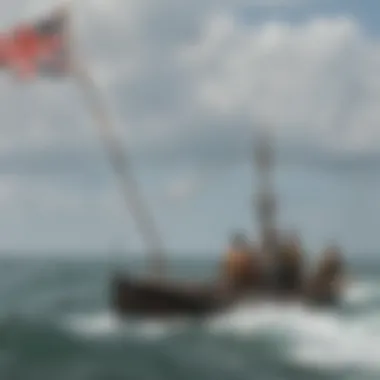
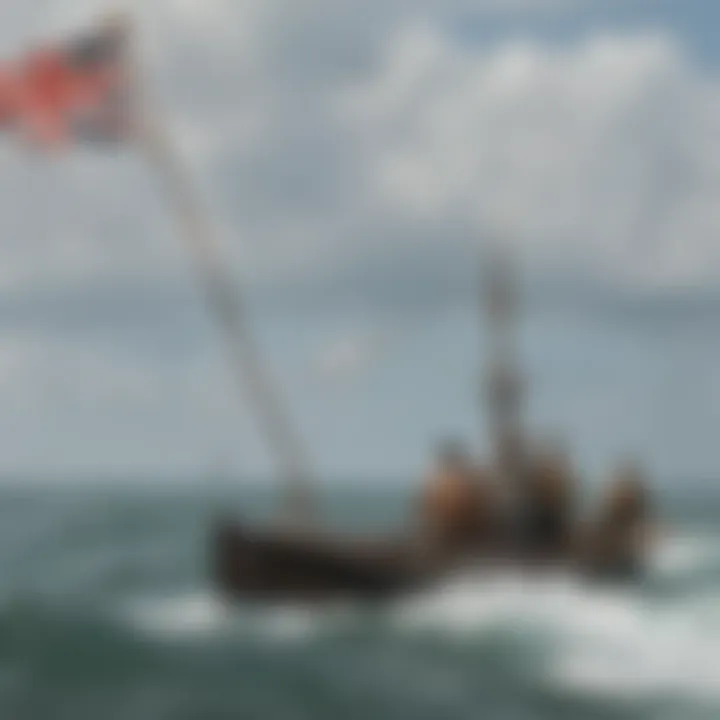
The flags are tied to a system of phonetic alphabet, meaning each flag also corresponds to a word. For instance, the flag for "A - Alpha" is often associated with the phrase "I have a diver down; keep well clear at slow speed." Such connections make recalling the meanings easier, especially during high-pressure situations on the water.
Here’s a little peek at the main structure:
- A - Alpha
- B - Bravo
- C - Charlie
- D - Delta
- E - Echo
And so it goes through to Z - Zulu. Each letter's flag plays a crucial role, forming a complete communication system for vessels.
Official Recognition and Standards
The International Maritime Organization governs the use and interpretation of the maritime flag alphabet. It has set standards that ensure every flag is uniformly recognized globally. This is significant for international maritime laws and practices. The flags are outlined in the International Code of Signals (ICS), providing a clear reference for sailors around the world.
The standardization helps eliminate misunderstandings that could arise from local variations in flag design. In addition, it fosters a universal language among seafarers, bridging the gap between different nationalities. With respect to safety, consistency in flag signaling reduces the risk of miscommunication, particularly in emergency situations.
"The maritime flag alphabet isn’t just a set of pretty colors; it’s a language that saves lives on the high seas."
Tools like the ICS are not just useful for professional maritime communication; they are also beneficial for leisure and water sports activities. Understanding these standards can enhance the enjoyment and safety during sailing trips.
In summary, grasping the structure and the standards of the maritime flag alphabet provides an essential foundation for effective communication at sea, enriching the experience of anyone engaged in maritime activities.
Components of the Maritime Flag Alphabet
Understanding the maritime flag alphabet is pivotal for efficient and clear communication at sea. This coded language, utilized by vessels, allows sailors to relay important messages visually, facilitating safety and collaboration on the open water. Recognizing the components of this alphabet reveals not just how messages are conveyed, but also the rich history and careful design behind each flag. Notably, the maritime flag alphabet is not only a practical tool but also a cultural emblem that represents a long-standing tradition of seafaring.
Detailed Flags of the Alphabet
Each letter of the maritime flag alphabet possesses distinct characteristics that serve a specific purpose. The design choices, colors, and symbols all collectively enhance the communication capabilities while embodying meanings that go beyond the surface. Let’s consider each flag in detail to understand their significance:
A - Alpha
Alpha is represented by a white and blue flag with a distinct triangular shape. Its primary contribution to maritime communication is its function as a signal for divers in the water, indicating that it is unsafe to navigate in that area. The distinctive shape makes it easily identifiable from a distance, which is crucial in clear, fast exchanges during critical moments at sea. The unique feature here is its specific association with diver alert signals. However, on the flip side, some smaller vessels might find it challenging to recognize this flag among more complex backgrounds, which is a limitation.
B - Bravo
The Bravo flag, with its vibrant red coloring, represents the need to signal a fire aboard or that a vessel is carrying hazardous materials. Its brightness ensures it catches the attention of nearby vessels. This flag is popular for emergencies where immediate recognition is essential. Nevertheless, the downside can occur when the surrounding environment is also prominent in red hues, potentially leading to some misinterpretation or confusion.
- Charlie
The Charlie flag exhibits a blue and white alternating pattern, utilized often to convey that a vessel is carrying dangerous cargo or that a particular action is authorized. Its checkered pattern stands out among the usual square flags seen at sea. A key element is its design, which helps any ship navigating closely to it get the message clearly. One disadvantage could be that its colors might mislead if viewed from a distance, especially in varying weather conditions.
- Delta
The Delta flag is another crucial part of maritime signaling, depicted in a yellow and blue triangular composition. It signals the need for the vessels not to enter a restricted area or indicates the presence of personnel working on the water. This flag’s unique triangular form can easily differentiate it from the traditional square shapes, enhancing recognition rates at sea. However, busy ports could lead to miscommunication if multiple vessels utilize this flag simultaneously, leading to potential ambiguity.
E - Echo
Represented with a horizontal red and white stripe, the Echo flag serves an important role in indicating that the sailor requires assistance. Its striking design aids in drawing attention from nearby vessels. This simplicity means it is quite effective in urgent situations but could become lost in environments with a lack of visibility.
F - Foxtrot
The Foxtrot flag features a red background with a white cross—this flag signals that the vessel is engaged in some form of maneuvering. Its bright colors prevent it from blending into the backdrop of blue water or gray skies, which is highly beneficial in keeping sailing directions clear. However, interpreting this flag’s exact meaning can sometimes be a challenge for those unfamiliar with its specifications, especially in busy maritime areas.
G - Golf
With a distinct yellow background and black stripes, the Golf signal indicates that a vessel is unable to navigate due to iceberg threats or other unusual circumstances. This use of color greatly boosts visibility in icy waters or rough conditions. Yet, it could lead to confusion if the nearby vessels are not clued into this particular designation, prompting the need for additional safety signals.
H - Hotel
The Hotel flag is recognized by its striking blue and white. It signifies that a vessel is reportedly engaged in operations with pilots. This flag’s clear design allows for quick understanding, which is paramount for vessels approaching ports. As a downside, if used improperly outside designated regions, it might lead to operational misunderstandings.
- India
The India flag is easy to identify with its distinctive vertical red and white stripe. This flag denotes the presence of a vessel with a need for an observer and indicates preparations for arrival. By standing out in numerous conditions, this flag is extremely effective. However, its usage can create busy interactions around arrival ports, which, without coordination, might lead to confusion.
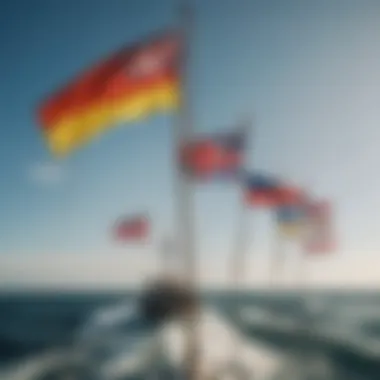
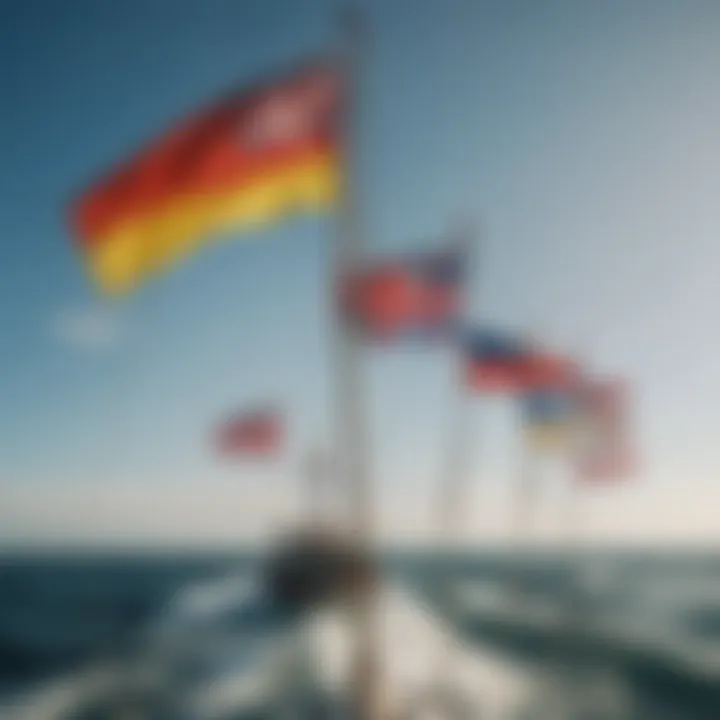
J - Juliett
Marked by a blue and white design, the Juliett flag signifies a vessel that is linked to quarantine. This visually clear design helps convey important health safety regulations at sea. If someone fails to recognize this flag, especially in congested waters, it can lead to unnecessary complications.
Continue detailing the flags for K - Kilo through Z - Zulu similarly by discussing their uses, key characteristics, unique features, advantages, and disadvantages. Providing this complete overview will equip readers with both foundational knowledge and nuanced understanding of the maritime flag alphabet.
Colors and Patterns in Flag Design
The colors and patterns incorporated in maritime flags play a vital role in their communication abilities. For instance, bright colors like red and yellow are often chosen for visibility against the backdrop of the sea and sky. Patterns, like stripes and checks, can add additional layers of meaning or context to messages being sent. Exploring the psychology behind these design choices contributes significantly to appreciating how maritime flags serve their purpose in a meaningful way.
David G. Brown once said,
"The ocean stirs the heart, inspires the imagination, and brings eternal joy to the soul."
This speaks to the beauty and functionality of central elements like the maritime flag alphabet that illustrate human connection and creativity, even against the vast ocean backdrop.
Practical Applications of Maritime Flags
The practice of using flags in maritime settings extends far beyond simple decoration. In the realm of sailing and nautical navigation, the maritime flag alphabet plays a pivotal role. It transcends mere tradition, becoming an essential communication tool among seafarers. Here, we delve into the practical applications of these flags, highlighting their significance in both professional settings and leisure activities.
Professional Maritime Communication
In the bustling world of maritime operations, the ability to communicate effectively is crucial. Ships operating on open waters or in busy ports often face challenges due to noise, distance, and other environmental factors. Here, maritime flags come to the rescue, offering a reliable form of communication that requires no audio or electronic support.
The maritime flag alphabet serves several key functions in professional settings:
- Safety Protocol: Ships use flags to signal distress, indicate their status, or communicate urgent information to other vessels. For instance, the flag for November can alert other ships to a man overboard situation, enabling quick rescue efforts.
- Navigation Assistance: Specific flags can designate various navigational statuses—like the Victor flag indicating a vessel that is anchored, or the Charlie flag signaling a vessel that is seeking assistance.
- Regulatory Compliance: Maritime flags also help in adhering to international maritime laws and standards. By displaying appropriate flags, vessels can signify when they are operating under certain regulations or requesting specific permissions.
In high-stakes environments like shipping lanes and fishing waters, these flags act as visual cues vital for maintaining safety and order. Using flags effectively can therefore mean the difference between a seamless operation and costly accidents.
Leisure and Watersports Usage
While the professional world harnesses the flag alphabet for critical communication, the world of leisure and watersports also embraces the maritime flag system in enriching ways. Yachts, sailing schools, and recreational boaters regularly employ flags for various purposes.
- Fun Competitions: Yacht races often display flags for signaling race starts, course changes, or penalties. A sailboat displaying the Foxtrot flag, for example, may signal that the race is underway, providing excitement and clarity.
- Instructional Tool: For sailing schools, integrating flags into lessons helps students grasp critical concepts. By learning what each flag means, they enhance their overall maritime knowledge, turning learners into confident sailors.
- Community Bonding: Using flags during events or group outings can create a sense of unity among participants. A flotilla of boats all flying the Yankee flag, for instance, cultivates camaraderie and shared purpose among participants in a sailing festival.
In the recreational realm, flags foster connections, camaraderie, and an appreciation for the seafaring culture. Catering to adventure seekers and sport enthusiasts alike, they serve both functional and aesthetic roles that draw sailors and water-goers together.
"Maritime flags are not just fabric; they are the whispers of the ocean, communicating across distances where sound fails."
In summary, the practical applications of maritime flags are both essential and enriching. Whether in the professional or leisure context, these colorful banners serve as a vital means of communication that embodies the spirit of maritime culture.
Educational Perspectives on Flag Signaling
Understanding the maritime flag alphabet is not just a matter of memorizing symbols; it’s diving into a realm that combines history, culture, and practicality in nautical communication. The educational perspectives on flag signaling enrich both experienced seafarers and those just stepping into the world of watersports, creating a well-rounded appreciation for this unique form of signaling.
One significant aspect of educational approaches to flag signaling is the promotion of safety at sea. Knowing how to properly use and interpret flags can often be the difference between life and death in an emergency situation. For instance, flags like the Alpha flag signify that a vessel is divers down, alerting nearby boats to maintain a safe distance. Thus, understanding flags within a practical context can lead to more informed and safer recreational boating experiences.
Moreover, incorporating flag signaling into curricula for maritime training enhances the professional capabilities of future mariners. Training institutions emphasize not just the memorization of flags, but the interpretation of their meanings in varied scenarios, equipping students with the tools needed to make quick decisions under pressure. This layered understanding can boost confidence among novice sailors, as they learn to navigate through potential misinterpretations during critical moments.
"Effective communication is the backbone of maritime operations; knowing your flags is essential to staying afloat in windy situations."
The integration of flags into educational programs is not limited to formal instruction. Community sailing groups and local boat clubs often emphasize flags during beginner courses, making signaling fun and relatable. Instructors can use creative teaching methods like games or flag-themed challenges, which not only make learning engaging but also foster camaraderie among participants. The social aspect of these learning environments encourages shared experiences, drawing students in with their enthusiasm and interest.
Instructional Methods for Learning Flags
Effective instructional methods are paramount for people learning flag signaling. Traditional teaching strategies, like rote memorization, are clearly not the most engaging way to grasp each flag's significance. Instead, a multifaceted approach tends to yield better results.
- Visual Aids – Flashcards depicting each flag with its corresponding letter and meaning can serve as a handy reference, especially when practiced during drills.
- Interactive Workshops – Hands-on workshops allow learners to engage directly with flags, offering real-time practice and immediate feedback in a controlled environment.
- Scenario-Based Training – Using real-life scenarios helps learners apply their knowledge to practical situations. For example, simulating a man-overboard scenario where participants need to signal for help using specific flags can solidify their understanding.
These methods not only help in retention of information but also instill confidence, which is crucial when out on the water.
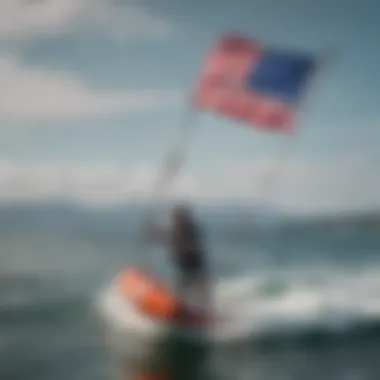
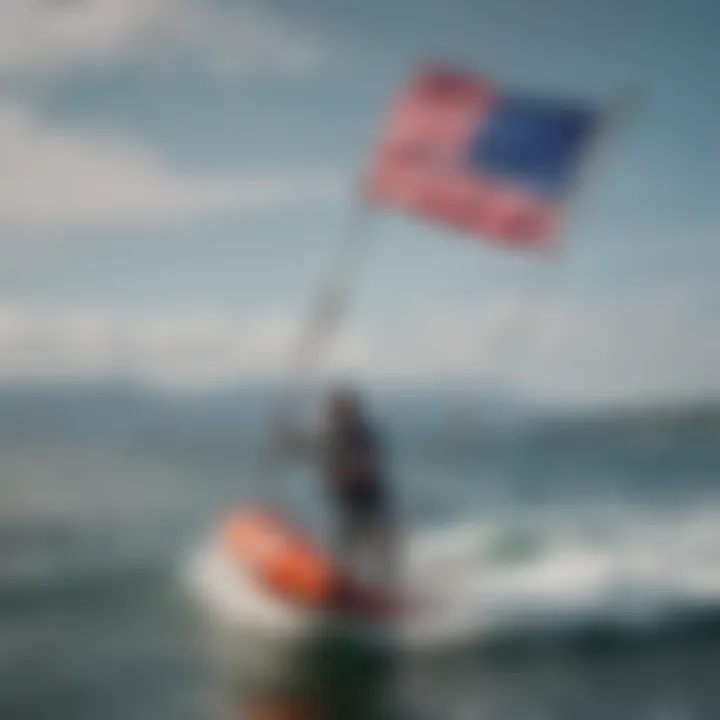
Incorporating Flags in Watersports Curricula
In the realm of watersports, ensuring participants understand flag signaling is equally essential. Instructors can create integrated lessons that cover both technical skills and maritime communication through flags.
- Cross-Training: Instructors can incorporate flag signaling into different watersports. A windsurfing lesson could involve a discussion about flags relevant to strong wind warnings and how to communicate in real-time.
- Flag Challenges: Holding friendly competitions around recognizing and responding to flag signals can turn learning into a collaborative effort. It fuels a sense of unity and competition among the participants.
- Safety Drills: Regular safety drills that require the use of flags can reinforce the habit of signaling. Practicing with flags ensures participants know how to communicate important messages before they encounter real situations.
Overall, integrating educational perspectives on flag signaling into all training and recreational platforms creates a knowledgeable community of sailors and watersport enthusiasts. This foundation of understanding enhances safety, builds confidence, and cultivates a shared respect for maritime traditions.
Challenges and Limitations of Flag Communication
In the realm of maritime navigation, flag communication stands as a vital instrument for conveying messages across vast bodies of water. However, despite its historical significance and established system, several challenges and limitations impact its effectiveness. Recognizing these obstacles is crucial for those who rely on maritime flags, as it enhances their understanding and ensures accurate interpretation in various scenarios.
Environmental Factors Impacting Visibility
One of the most pressing issues affecting flag communication is visibility, heavily influenced by environmental conditions. An overcast sky or thick fog can render flags nearly invisible to the naked eye, making it tough for ships to spot incoming signals. It's not just about the absence of light; excessive glare from the sun can bounce off the water, causing reflections that obscure flags further. Wind also plays a vital role, as low gusts may not be enough to fully unfurl a flag, rendering it ineffective. For instance, imagine a situation where two vessels are trying to communicate during a storm. High winds may whip the flags around, leading to confusion about the signal being conveyed.
Other environmental factors, such as waves, can disrupt visual clarity. High swells could obscure a flag’s visibility for a ship positioned lower on the water. Therefore, mariners must remain cognizant of their surroundings when relying on flags to communicate, as a simple squall can throw their signaling efforts off course. To combat these issues, captains may employ additional measures like using radio communication during inclement weather, ensuring clearer channels of understanding when the visual signals fall short.
Misinterpretations and Errors in Signaling
Even in optimal conditions, the potential for misinterpretation looms large. Flag signaling relies on a uniform understanding of each flag’s meaning, which can sometimes lead to errors in communication. When dealing with different nationalities in international waters, the haphazard application of meaning can lead to miscommunication. For instance, a signal that is widely accepted in one region might be misinterpreted elsewhere, leading to possible conflict or confusion.
Moreover, human error plays a significant role in these misinterpretations. Crew members may not be well-versed in flag signals or may misread the flags displayed due to fatigue or distraction. In hectic maritime environments, where multiple signals may be exchanged quickly, the risk of error increases dramatically.
To mitigate these pitfalls, ongoing training should be a priority for all maritime personnel. Regular drills and refreshers about flag signaling can ensure that misunderstandings are minimized and clarity is maintained.
In summary, while flag communication serves as a fundamental part of navigational practices, both environmental challenges and the potential for misinterpretation present significant limitations. Understanding these factors is essential for any mariner aiming to navigate successfully through the intricate dance of maritime communication.
"Without a clear signal in a storm, confusion reigns supreme on the open sea."
With a greater awareness of the factors at play, sailors can better navigate the complexities of conveying messages through flags, ensuring that communication remains as smooth as possible, even when the elements conspire against them.
The Future of Maritime Flag Signaling
As we sail into an era marked by rapid technological advancement, the future of maritime flag signaling holds both exciting possibilities and key challenges. This section examines how modern innovations can reshape the way flags are used at sea, while also discussing the importance of preserving the age-old traditions that underpin maritime communication.
Technological Innovations in Naval Communication
The landscape of naval communication is evolving due to technological innovations. Various tools and platforms come into play, but not all can fully replace the tried-and-true methods of maritime flags. For instance, digital communication systems may offer seamless data transmission, yet flag signaling provides unmistakable visibility and simplicity that machines can't replicate during emergencies.
Some notable innovations include:
- Satellite Communication: While it connects vessels across the globe, its reliance on system integrity introduces potential vulnerabilities.
- Automated Identification Systems (AIS): These systems help track vessels, but they may not convey urgent messages on the fly as effectively as immediate flag signaling can.
- Mobile Apps for Communication: Although these apps can help with coordination and message relay, the necessity of strong connectivity limits their functionality in remote areas.
It’s essential to acknowledge that technology can enhance the effectiveness of flag signaling by providing more context, such as integrating flags with GPS data to give position information. This combination could lead to an impressive hookup, blending traditional maritime culture with the efficiency of technical advancements.
Preservation of Traditional Signaling Methods
While we look ahead, safeguarding traditional signaling methods is equally important. The maritime flag alphabet embodies a rich history of communication, culture, and navigation wisdom. In this fast-paced digital world, the simplicity and reliability of flag signaling can sometimes get lost in the noise.
Here are some reasons why preservation matters:
- Cultural Heritage: The flag signaling system is a significant cultural artifact that tells the story of humanity’s relationship with the sea.
- Emergency Signaling: In vital situations, flags often serve as the last resort for signaling, where high-tech methods may fail.
- Training and Education: Understanding the nuances of flag signaling is critical for anyone aiming for a maritime career, ensuring the next generation of sailors is grounded in proven techniques.
In light of modern advancements, it’s vital to incorporate flag signaling into educational programs, ensuring that future maritime professionals grasp not just the technical skills, but also the importance of tradition in maritime culture.
"In embracing the future, we must not forget our roots. The maritime flag alphabet isn't just a collection of colors; it's a language born from the unyielding spirit of the sea."
Ultimately, a balanced approach that leverages innovative solutions while honoring traditional methods will ensure that maritime flag signaling remains pivotally relevant for many years to come.
Culmination
In wrapping up this exploration of the maritime flag alphabet, it becomes apparent that this system of communication is much more than mere colored cloth fluttering in the wind. It embodies a rich tradition and serves as a vital link between maritime vessels. The importance of understanding how to interpret these flags cannot be overstated, especially in an age where effective communication at sea is paramount for safety and operational efficiency.
One cannot ignore the profound applications of maritime flags in various nautical settings. From fishing boats signaling their haul to luxurious yachts engaging in friendly races, the flag alphabet provides a universal language that all sailors can understand. Consider the simplicity yet effectiveness of using flags to communicate messages over long distances, where voice might fail. It's a dance of colors and shapes that conveys an array of meanings without the need for technology, which is crucial when one considers that power outages or equipment failures could occur at sea.
Moreover, as we look ahead, the future of maritime flag signaling stands at a crossroads. On one hand, technology continues to advance, introducing tools like GPS and digital communication systems. Yet, on the other hand, there's a distinct charm and logic to using flags that should not be discarded. Thus, preserving these traditional methods remains crucial, as they have been the backbone of maritime communication for centuries.
To encapsulate, understanding the maritime flag alphabet is indispensable not just for seafarers, but also for enthusiasts, educators, and anyone interested in maritime culture. The flags symbolize a bridge across the water, a heritage of navigational skills, and a sophisticated method of communication that remains relevant despite the sweeping tide of modern technology. As one navigates through the waters of this knowledge, the appreciation for what lies beneath these flags deepens, portraying them not merely as tools, but as storytellers of the sea.







